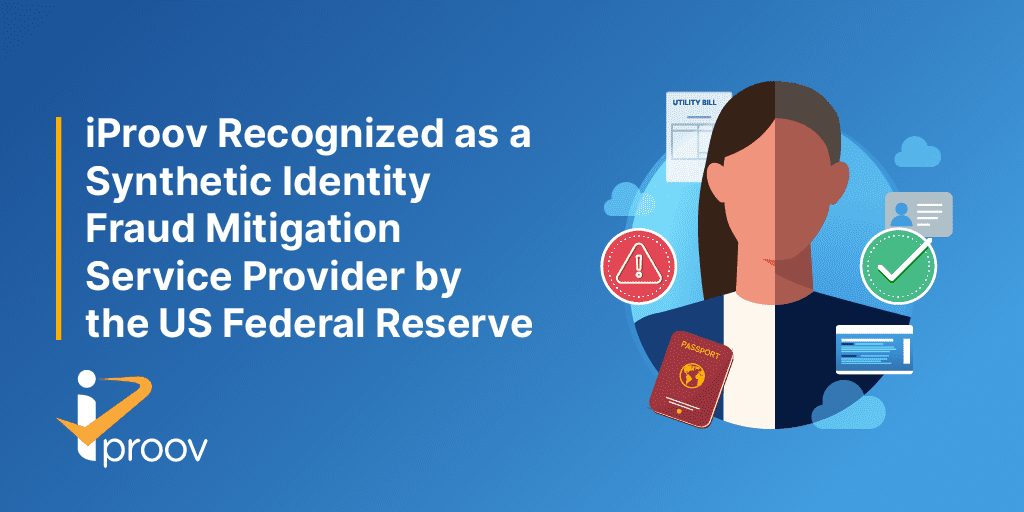November 14, 2022
Organizations don’t just need to be wary of stolen identities; there’s a growing threat of onboarding users who aren’t even “real” people.
Synthetic identity fraud is the fastest-growing type of financial fraud in the United States, surpassing ‘true name’ identity fraud (where a criminal uses a real person’s identity. It accounted for an estimated $20 billion in losses for U.S. financial organizations in 2020.
In response to this growing threat, the Federal Reserve – the central banking system of the United States of America – has released a list of vendors in a drive to help combat synthetic identity fraud. The toolkit aims to help businesses “reduce the time required to locate providers and their synthetic identity fraud mitigation offerings”.
Read on to learn more about the Federal Reserve’s toolkit, synthetic identity fraud, and how iProov can help you mitigate it.
What is Synthetic Identity Fraud?
Synthetic Identity Fraud is a highly sophisticated and hard-to-spot form of online fraud that differs from identity theft. Instead of stealing a real person’s identity, synthetic fraudsters create a ‘person’ who doesn’t exist by using stolen, fictitious, or manipulated Personally Identifiable Information (PII), for the purposes of opening and using an account for illegal activities.
Learn more about synthetic identity fraud:
- Biometric Encyclopedia: Synthetic Identity Fraud
- Synthetic Identity Fraud: What Is It and How Can You Prevent It?
Why Does the Federal Reserve Highlight iProov for Synthetic Identity Fraud Mitigation?
It’s in the Federal Reserve’s best interest to keep payment systems secure and fraudsters out. And synthetic identity fraud is perhaps one of the most concerning threat types. A study from Aite Novarica Group found that synthetic identity fraud is growing quickly, with losses estimated to rise from US$1.8 billion in 2020, to $2.42 billion in 2023 – and that’s just on unsecured credit products in the US alone.
The Federal Reserve recognizes iProov’s differentiation at the point of binding identity information with a real live human, ensuring that the individual is doing so in real-time and is not a recording or injected video.
As a best-in-class biometric authentication and verification vendor, our Dynamic Liveness technology offers cloud-based, secure, and passive biometric face authentication with industry-first anti-spoofing technology.
Additionally, our industry-first active threat mitigation service delivered through the iProov’s Security and Operations Center (iSOC) provides insights into novel threat vectors, enabling resilience against sophisticated emerging attacks. This means only iProov can mount appropriate defenses as the threat landscape continues to evolve – even when fraudsters try to pretend to be someone they are not.
How Does iProov Combat Synthetic Identity Fraud?
The big problem with synthetic identity fraud is that for all intents and purposes, a synthetic identity can look like a real customer with verifiable information backing up their identity. The detection and prevention of synthetic identity fraud requires a layered approach.
iProov helps to confirm if the person asserting their identity is the right person, a real person and is actually present during the authentication. Dynamic Liveness analyzes whether the person themselves is genuine – rather than just trusting the identity information provided. If the individual is using any form of manipulation typically seen with synthetic attacks – such as replayed videos, deepfakes, or presentation attacks (masks, for example) to circumvent verification, Dynamic Liveness will detect and mitigate the threat. This is a key defense alongside other identity verification steps in preventing synthetic identity fraud.
How does it work?
Essentially, face biometric verification from iProov works by asking a user to scan their government-issued identity document and then scanning their face. Even if someone has a verifiable synthetic identity that would pass simple background checks, iProov would stop someone trying to circumvent the authentication process using an impersonation, presentation, or digitally injected attack.
Flashmark™ technology illuminates the user’s face with a unique sequence of colors that cannot be replayed or manipulated synthetically. This assures a user is authenticating right now. Additionally, illumination provides greater assurance using multi-dimensional information from the face to confirm it is a real person. This passive verification doesn’t rely on motion or other actions which can be easily repeated with synthetically generated motion or responses.
The process takes just a few seconds and confirms that the user is the right person, a real person, and that they are verifying their identity right now, and in real time.
iProov, The Federal Reserve, and Synthetic Identity Fraud: Summary
- The Federal Reserve published a list of vendors that can help identify and combat synthetic identity fraud risks as part of their Synthetic Identity Fraud Mitigation Toolkit. iProov was highlighted on this list.
- Synthetic identity fraud works by combing manipulated or falsified data, which can often undermine traditional fraud prevention systems.
- Active biometric solutions are easier to spoof as the action can be repeated synthetically.
- iProov is well-positioned to combat synthetic identity fraud because we offer best-in-class passive liveness detection and, critically, verify that a user is authenticating in real time. This combats many of the attack types fraudsters use to bolster synthetic identities – such as replay attacks, presentation attacks, and deepfakes. Most vendors cannot offer such protection.
If you’d like to see how iProov’s technology can bring effortless security to your onboarding and authentication processes – while helping to combat synthetic identity fraud – book your iProov demo here.
